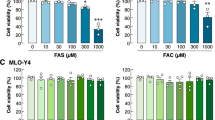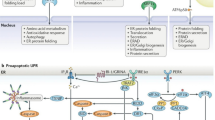Abstract
Aging reduces bone mass as well as the anabolic response of bone to mechanical stimuli, resulting in osteopenia. Endoplasmic reticulum (ER) stress impairs the response of myogenic cells to anabolic stimuli, and is involved in sarcopenia, but whether ER stress also contributes to osteopenia is unknown. Therefore, we tested whether ER stress exists in bones of aged mice, and whether this impairs the osteocyte response to mechanical stimulation. Primary osteocytes were obtained from long bones of adult (8 months) and old (24–26 months) mice, treated with or without the pharmacological ER stress inducer tunicamycin, and either or not subjected to mechanical loading by pulsating fluid flow (PFF). The osteocyte response to PFF was assessed by measuring cyclooxygenase-2 (Cox-2) mRNA levels and nitric oxide (NO) production. mRNA levels of ER stress markers were higher in old versus adult osteocytes (+40 % for activating transcription factor-4, +120 % for C/EBP homologous protein, and +120 % for spliced X-box binding protein-1, p < 0.05). The Cox-2 response to PFF was fourfold decreased in cells from old bones (p < 0.001), while tunicamycin decreased PFF-induced Cox-2 expression by threefold in cells from adult bones (p < 0.01). PFF increased NO production by 50 % at 60 min in osteocytes from old versus adult bones (p < 0.01). In conclusion, our data indicate that the expression of several ER stress markers was higher in osteocytes from bones of old compared to adult mice. Since ER stress altered the response of osteocytes to mechanical loading, it could be a novel factor contributing to osteopenia.


Similar content being viewed by others
References
Bacabac RG, Smit TH, Cowin SC, Van Loon JJ, Nieuwstadt FT, Heethaar R, Klein-Nulend J (2005) Dynamic shear stress in parallel-plate flow chambers. J Biomech 38:159–167
Bakker AD, Klein-Nulend J, Burger EH (2003) Mechanotransduction in bone cells proceeds via activation of COX-2, but not COX-1. Biochem Biophys Res Commun 305:677–683
Bakker AD, Klein-Nulend J, Tanck E, Albers GH, Lips P, Burger EH (2005) Additive effects of estrogen and mechanical stress on nitric oxide and prostaglandin E2 production by bone cells from osteoporotic donors. Osteoporos Int 16:983–989
Bassik MC, Kampmann M (2011) Knocking out the door to tunicamycin entry. Proc Natl Acad Sci USA 108:11731–11732
Birkhold AI, Razi H, Duda GN, Weinkamer R, Checa S, Willie BM (2014) The influence of age on adaptive bone formation and bone resorption. Biomaterials 35:9290–9301
Bonewald LF, Johnson ML (2008) Osteocytes, mechanosensing and Wnt signaling. Bone 42:606–615
Brown MK, Naidoo N (2012) The endoplasmic reticulum stress response in aging and age-related diseases. Front Physiol 3:263
Deldicque L (2013) Endoplasmic reticulum stress in human skeletal muscle: any contribution to sarcopenia? Front Physiol 4:236
Deldicque L, Bertrand L, Patton A, Francaux M, Baar K (2011) ER stress induces anabolic resistance in muscle cells through PKB-induced blockade of mTORC1. PLoS One 6:e20993
Deldicque L, Cani PD, Philp A, Raymackers JM, Meakin PJ, Ashford ML, Delzenne NM, Francaux M, Baar K (2010) The unfolded protein response is activated in skeletal muscle by high-fat feeding: potential role in the downregulation of protein synthesis. Am J Physiol Endocrinol Metab 299:E695–E705
Forwood MR (1996) Inducible cyclo-oxygenase (COX-2) mediates the induction of bone formation by mechanical loading in vivo. J Bone Miner Res 11:1688–1693
Griess P (1879) Bemerkungen zu der abhandlung der H.H. Weselsky und Benedikt “Ueber einige azoverbindungen”. Chem Ber 12:426–428
Hoshi A, Watanabe H, Chiba M, Inaba Y (1998) Effects of exercise at different ages on bone density and mechanical properties of femoral bone of aged mice. Tohoku J Exp Med 185:15–24
Klein-Nulend J, Sterck JG, Semeins CM, Lips P, Joldersma M, Baart JA, Burger EH (2002) Donor age and mechanosensitivity of human bone cells. Osteoporos Int 13:137–146
Leppanen OV, Sievanen H, Jokihaara J, Pajamaki I, Kannus P, Jarvinen TL (2008) Pathogenesis of age-related osteoporosis: impaired mechano-responsiveness of bone is not the culprit. PLoS One 3:e2540
Lowik CW, Nibbering PH, van de Ruit M, Papapoulos SE (1994) Inducible production of nitric oxide in osteoblast-like cells and in fetal mouse bone explants is associated with suppression of osteoclastic bone resorption. J Clin Invest 93:1465–1472
Ralston SH, Uitterlinden AG (2010) Genetics of osteoporosis. Endocr Rev 31:629–662
Sandhu SK, Hampson G (2011) The pathogenesis, diagnosis, investigation and management of osteoporosis. J Clin Pathol 64:1042–1050
Schroder M, Sutcliffe L (2010) Consequences of stress in the secretory pathway: the ER stress response and its role in the metabolic syndrome. Methods Mol Biol 648:43–62
Soejima K, Klein-Nulend J, Semeins CM, Burger EH (2001) Different responsiveness of cells from adult and neonatal mouse bone to mechanical and biochemical challenge. J Cell Physiol 186:366–370
Sterck JG, Klein-Nulend J, Lips P, Burger EH (1998) Response of normal and osteoporotic human bone cells to mechanical stress in vitro. Am J Physiol 274:E1113–E1120
Weiss A, Arbell I, Steinhagen-Thiessen E, Silbermann M (1991) Structural changes in aging bone: osteopenia in the proximal femurs of female mice. Bone 12:165–172
Acknowledgments
This research was funded by the European Commission through MOVE-AGE, an Erasmus Mundus Joint Doctorate program (2012–2016). The authors would like to thank Cornelis Semeins, Guus Baan, and Gerard de Wit for technical assistance.
Conflict of interest
Sreeda Chalil, Richard T Jaspers, Ralph J Manders, Jenneke Klein-Nulend, Astrid D Bakker, and Louise Deldicque declare no conflict of interest.
Human and Animal Rights and Informed Consent
The use of animals in this study was approved by the animal care and use committee of the VU University Amsterdam.
Author information
Authors and Affiliations
Corresponding author
Rights and permissions
About this article
Cite this article
Chalil, S., Jaspers, R.T., Manders, R.J. et al. Increased Endoplasmic Reticulum Stress in Mouse Osteocytes with Aging Alters Cox-2 Response to Mechanical Stimuli. Calcif Tissue Int 96, 123–128 (2015). https://doi.org/10.1007/s00223-014-9944-6
Received:
Accepted:
Published:
Issue Date:
DOI: https://doi.org/10.1007/s00223-014-9944-6




